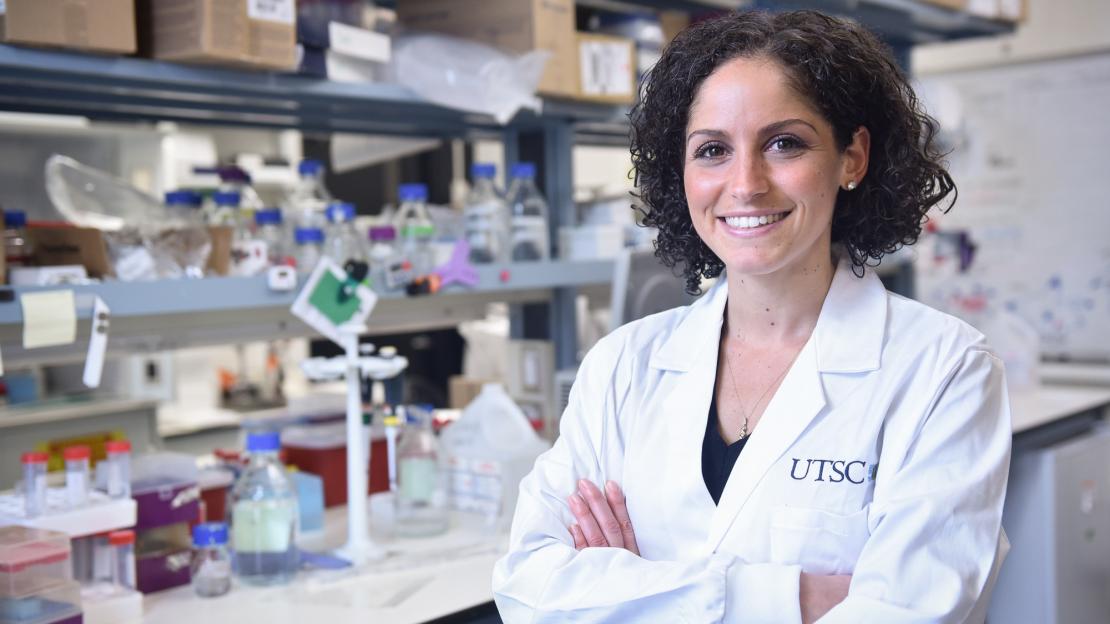Professor Christina Guzzo studies HIV infection in her lab at U of T Scarborough. She shared how she mentors grad students and undergraduates based on the best traits of those who trained her.
Guzzo excelled at sports as a youth and was curious about the way the body works and how it stays healthy, so she pursued a BScH in life sciences at Queen’s University. She found her courses engaging, but Guzzo’s PhD supervisor, Professor Katrina Gee, taught her that science could be fun. When Guzzo performed the first protein separation in Gee’s new laboratory, they danced together in excitement at their first result. This was when Guzzo formed interest to build a career in academiaand exuberance about science that she now models for her trainees.
Being the first grad student in Gee’s lab meant that Guzzo could not explore wild ideas but had to ensure that each experiment would support meaningful and publishable progress. This taught Guzzo the importance of establishing solid groundwork for experiments.

With efficiency, Guzzo had a remarkable output of five first-author papers by the end of her PhD, and another six co-authored works. The week of her PhD defence culminated with running the Boston Marathon, giving her 42 km to reflect on all that transpired in grad school. Indeed, distance running has been a critical element of Guzzo’s career trajectory, an outlet to reflect and think.
Pursuing wild scientific ideas had to wait until Guzzo earned a postdoctoral fellowship at the National Institutes of Health (NIH) in Bethesda, USA. She studied HIV infection under the supervision of Drs Paolo Lusso and Anthony Fauci, world-renowned scientists, for their contributions to the HIV field. They had all the funding, equipment, and patient samples they needed at the NIH, so the only limit was their inventiveness.
There were new lessons in mentoring; with these resources came the intense drive to use them responsibly and with the seriousness and urgency that a decades-long pandemic virus required. Drs Lusso and Fauci modelled devotion to science; despite their high-profile positions, emails were responded to in real-time, and research was pushed forward 365 days a year. While not an entirely healthy approach to science, Guzzo learned what is possible when ‘all systems are go.’
In the lab, Guzzo knew that cells respond to viral infection by turning on certain genes. In particular, human integrins were observed to be induced in HIV-infected cells, so Guzzo wanted to know how quickly the integrin protein was turned on in the infected T cells. She was incredulous at her results. “It’s there after one minute!? It’s there one second after infection?!” Then came her “Aha!” moment. This response was too quick for turning on a gene, so the protein must be present on the HIV virus when it is binding to the cell!
With supporting experiments to verify her novel findings, she polished the story with the guidance of Lusso and Fauci, published the work, and used this research as a foundation for her own lab at UTSC.
Although it appears like a seamless career trajectory into academia, the last year of Guzzo’s postdoc was wrought with personal adversity when she experienced the pre-term birth of a child with Down syndrome. Within one day she went from working productively in the lab to sitting at the crib side of her daughter in intensive care for four weeks straight.
When Guzzo made it back to the lab to finish her postdoc there was a new outlook on life. Family was cemented as a priority for Guzzo, and science came second.
Guzzo models this with her students and hopes to be the mentor that shows it is possible for a female scientist to put her family first, but only with adequate support systems, and a lot of hard work.
This story originally appeared on U of T's Department of Cell and Systems Biology website
